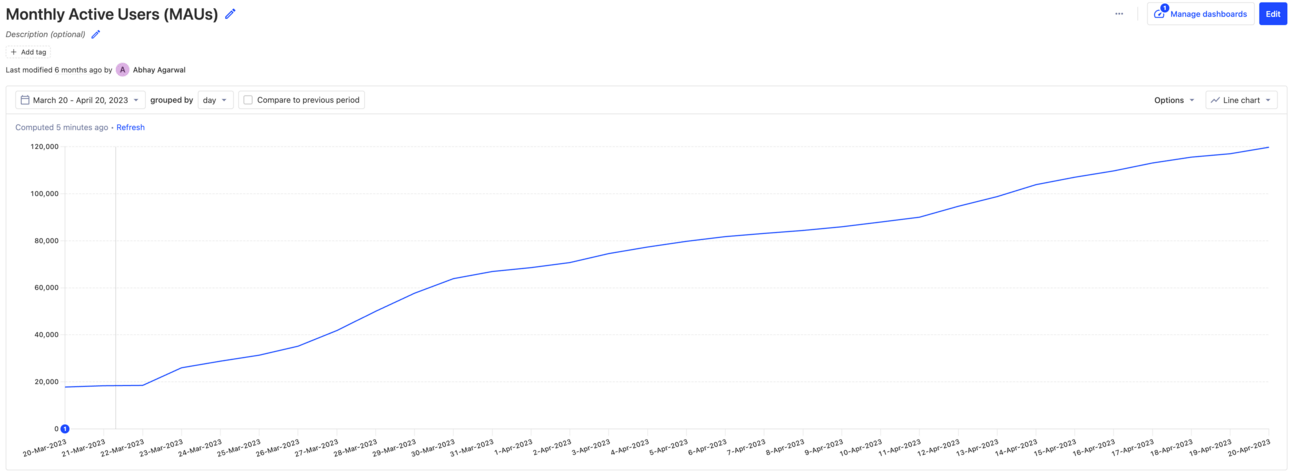- Startup Frontrow
- Posts
- How We Got 120K MAUs in 4 Weeks with NO Paid Ads | Poly Product Launch Story
How We Got 120K MAUs in 4 Weeks with NO Paid Ads | Poly Product Launch Story
The power of programmatic SEO and how you can leverage it

Background
I am the co-founder of Poly (https://withpoly.com/), a generative AI company for designers. Earlier this year, we released our first product for 3D rendering artists, interior designers, and game developers. These designers can use Poly to generate customized 8K seamless textures with 8 PBR maps in just a couple of seconds. Our tool can be directly accessed from a web browser without logging in. Within 4 weeks of our new GenAI features’ launch, we grew our monthly active user (MAUs) by 600% to reach 120K and our organic SEO traffic by 400%, with NO paid ads at all. In this post, I'll share our experience, tips, and how you can leverage the power of programmatic SEO.

20K - 120K MAUs in 4 weeks following product launch

4x organic SEO traffic and significant growth through word-of-mouth
How to set up a product-led growth model?
We have been adamant about building a product-led growth company from day 1. This model works particularly well for Poly because almost all of our target users are “pro consumers,” and they can pull out their wallets and make a purchase immediately after a short product trial. There is a certain degree of virality / “wow” factors directly built into our platform, given the ease of onboarding and a straightforward trial-to-value process.
Besides building our core generative AI capability and UI where users can come and create any customized textures with a simple text or image prompt, we also want to build a programmatic SEO growth flywheel directly into our platform. To “productize growth,” we carefully assembled a well-curated user-generated asset library of textures as our main landing page.

Poly’s landing page features a library of 1000s of HD seamless textures for free downloading. Each asset is a mini landing page to capture a particular set of search intentions.
We created this collection of 1000s of individual assets and intended to use each individual texture asset page as mini SEO landing pages to capture the long tail of search intentions on Google: “red Spanish marble texture for wedding,” “blue alien texture from Star Wars,” etc.

An example of a free HD texture from Poly that captures high-volume and long-tail keywords that designers usually use when searching for assets online.
When people search for these specific textures, they should be able to directly find our mini SEO landing pages in the web or image search results. From there, they can click in to download the sample textures on our website (for free) or edit/fine-tune the prompts used to generate these textures and make better and more customized premium textures (for a fee). In either scenario, Google will measure these interactions as high engagement / low bounce rate, which will help boost our SEO rankings and give more fuel to Google to crawl and index more asset pages on our website, further accelerating our growth flywheel.

Poly’s product-led growth flywheel: more textures → more indexed pages → better SEO → more people use Poly → more textures added to our library.
Kickstart a programmatic SEO growth flywheel
To kick off this programmatic SEO growth flywheel, we couldn’t just rely on Google’s crawler to magically find your website and index and present these 1000s of “programmatically” generated asset pages. We needed a fire starter to give Google a reason why they should spend money (in terms of server cost) to crawl our website.
For this, we ultimately relied on PR with the help of our investors and Y Combinator. A couple of weeks before our official launch, we coordinated a press release for Poly’s recent funding news and our mission and story in generative AI. The news article was published on TechCrunch, attracting 1000s of visitors to our website over the next few weeks. Here are a couple of interesting learnings here:
Backlinks from authoritative domains help but are not required to boost your SEO.
A common myth of SEO is that you need to have a lot of high-quality backlinks. While this is helpful, it’s not required at all. When our story went live on TechCrunch, the reporter actually did not include our website’s URL directly in the story. Most readers found us by Googling our name after reading the article. Overnight, we became one of the top 3 organic results for “AI texture generator” on Google, all without any major backlinks to our website. In a sense, the reporter actually did us a huge favor by NOT including our URL/backline in the article itself, which forced Google to learn more about us and rank us in a VERY short amount of time.
Getting Google to start crawling your web pages is half the battle. Be patient and creative. Execute.
Before our news article went live, we had been building our asset library for a few weeks already. We had submitted multiple requests in Google Search Console to request Google to crawl and index our individual asset pages without major progress. There are a couple of possible reasons. First, these are graphics-heavy pages that take a bit more resources for Google to crawl. Google tends to prioritize pages that are smaller in size and load faster (which is why Google’s “Page Experience” metrics are so important!) Secondly, we didn’t have any significant traffic on our website, which was why Google didn’t want to put too much effort into crawling our heavy pages. This was when creativity and execution needed to come in, and we tried out more than 15 different channels before our PR effort paid off and eventually got Google to crawl our website and “treat us seriously.” While the story for your startup’s growth roadmap is going to be very different, here is the list of channels that we experimented with during our cold start: personal social media pages (Twitter, Linkedin, IG), Product Hunt, email lists, YC community/Bookface, alumni board, Discord communities, Youtube (which I will talk more about later), Quora, Pinterest, post on traditional asset marketplaces, DMs, etc. The goal is to get some initial traffic in to “light the fire”.
Adding fuel to your programmatic SEO growth
Now that we kickstarted our SEO growth flywheel and that Google was steadily presenting more and more of our mini landing pages/individual assets on the first page of search results, we started to explore other ways to maintain and accelerate our growth. There are 3 areas we focused on:
Consistent A/B test on content: types, clusters of topics, internal linking, formats, etc.
This is probably one of the most important factors to sustain our SEO growth. Once we noticed our individual asset pages were performing well in search results, we continued to maintain and control the quality of assets we chose to feature in our library (all chosen from free user-generated textures) and released them in small but frequent batches based on topics, content, and what else was trending on the internet.
Additionally, we chose to incorporate additional types of content into our library. Besides individual pictures/textures, we tested and added many tutorials on how to work with these textures, how to use different 3D editing tools, and how to better use and leverage AI (prompt tips, etc.) Our goal was to build authority on various related clusters of topics that matter the most to our target audience and continue to A/B test each of these types of content’s performances. We interviewed our users and target audience excessively to source various relevant and interesting topics. We hired our actual customers instead of copywriters to generate the actual content.
Engagement, Engagement, Engagement
While the inner workings of Google SEO remain elusive, it's certain that Google’s main goal is to present the most relevant content for a given search intention to its users so the users stay on the page and engage. Google measures this in engagement, bounce rate, session length, etc.
There are many secondary metrics related to this: page load speed, number of backlinks, domain authority, etc., which are all designed to predict how likely and how long a Google user will choose to stay on the page that they click in a list of search results.
From a startup perspective, it means continuously optimizing your users’ landing experiences and helping them experience your product’s value as soon as possible. This whole topic is related to finding a product-market-fit or a product-market-niche that you can add unique value to your users. Interview your users, observe, and you will have the best answers that no other experts can provide. I will cover my learnings on how to conduct effective customer interviews in another post in the future. A quick hint: never directly ask them if your product is a good idea.
YouTube was the most effective SEO hack for us to accelerate our organic growth and search rankings on Google.
Increasingly, Google’s SEO algorithm has become more influenced by trends on other social media platforms and other media properties (online and offline) beyond Google’s traditional web search results. For Poly, this is particularly true with YouTube, although we have found that Twitter and other social media channels also helped quite a bit. Whenever we released a video, showcase, or tutorial with an artist on YouTube, our general web SEO traffic and organic rankings would get a meaningful bump over the next week or two, in addition to the traffic initiated directly from YouTube. It’s possible that since YouTube is a core part of Google’s offerings, there must be some “transferred learnings” of what’s popular on YouTube to traditional SEO web search result rankings. Again, no one knows this for sure, given the “black box” nature of Google SEO. The most important thing is to keep trying new channels/strategies and A/B testing. You will be surprised by what affects your web SEO rankings in the end.
The essence of growth hacking
In summary, while numerous growth hacking tips and tricks exist, there's no guaranteed formula for success that applies universally. The only thing you can do is to come up with a scientific and data-driven process to experiment and measure performances from A/B tests. Through this launch process, we experimented with more than 20+ channels and 250+ topic clusters and content pieces. Some of the tools we used include Google Search Console (for SEO monitoring), Posthog (for product and website analytics and user session recordings), Google Looker Studio (for processing our SEO data), and Notion (for hypothesis testing and tracking).
What is your experience with growth hacking? Any other tips or learnings you want to share? Please leave a comment here.
P.S.
If you are interested in what we are doing and our product-led growth model, my startup Poly (https://withpoly.com/) is hiring for Founding Frontend & ML engineers. We are a GenAI startup built for designers, backed by top VCs, including Felicis, Bloomberg, Figma, and YC, in an $8m round. If you are interested, please contact me on Linkedin and learn more here: Frontend & ML.
Reply